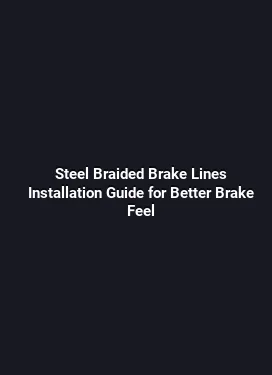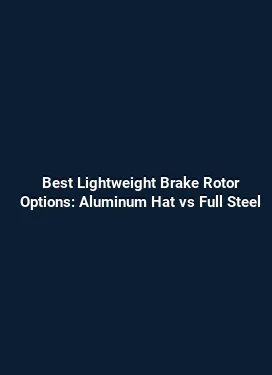Best Brake Cooling Ducts Installation for Track Day Heat Management
Track driving places significant demands on braking systems. Heat buildup can lead to brake fade, reduced pedal feel, and uneven stopping power. A well-designed brake cooling duct system helps channel cool air to the brake rotors and calipers, maintaining optimal temperatures, prolonging pad life, and preserving overall braking performance across sessions. This guide dives into practical considerations, material choices, and step-by-step installation tips that go beyond surface-level descriptions, offering real-world strategies for different vehicle platforms and track conditions.
Brake Cooling Duct Design for Track Day Heat Management

At its core, a brake cooling duct system moves ambient air from the high-pressure front of the car to the rotor faces, rotor hats, and caliper areas where heat tends to accumulate. The design must balance minimal drag with effective cooling, ensuring air paths are short, unobstructed, and aligned with existing bodywork or wheel wells. In practice, the most effective setups consider rotor size, rotor ventilation, pad compounds, and the typical track temperature range to tailor airflow paths accordingly.
One critical aspect is the source and path of the air. Duct ends located at or near the front bumper or wheel arch should feed air toward the rotor vents or the inner face of the rotor. It is essential to avoid creating new heat hotspots by routing air through regions with stagnant temperatures or to prevent interference with suspension travel and steering components. The goal is a smooth, direct path that reduces turbulence and delivers a predictable cooling effect under different loads and speeds.
Key Principles of Brake Cooling

Effective cooling relies on a few time-tested principles. First, temperature gradients matter: cold ambient air will absorb heat as it travels, so shorter, straighter ducts minimize heat exchange with hot under-hood areas. Second, pressure differentials drive flow; placing ducts where the incoming air is naturally accelerated (such as behind aerodynamic ducts or near cooling intakes) can increase the velocity that reaches the rotor without increasing drag. Third, duct sizing should reflect the braking system’s needs. Oversized ducts may sound appealing, but they can reduce ram effect and increase noise while adding weight without meaningful gains. Fourth, ensure a clean separation between cooling air and the intake air for the engine to prevent recirculation or flash heating of the air supply to the brake components.
LSI-friendly concepts naturally appear in this context as we discuss airflow continuity, low-turbulence bends, and minimized impedance. The resulting design yields more consistent rotor temperatures across multiple laps, which translates into steadier pedal feel and more repeatable braking performance even as ambient temperatures shift during a session.
Design considerations and airflow physics
Choosing the right duct configuration involves evaluating several interacting factors: rotor diameter, vented vs. solid rotors, wheel clearance, and caliper geometry. For track wheels with large calipers, intake routing should accommodate the caliper’s shape while preserving steering clearance at full lock. The ducts should terminate near brake discs or caliper mounting points without obstructing dust shields or wheel spokes. It’s also important to consider how heat migrates within the brake assembly; even with ducts, some heat will transfer through the rotor hat and the backing plate, so the focus should be on disrupting hot spots and creating uniform cooling zones.
Track environments vary widely. In high-ambient-temperature climates, the cooling benefit from ducts becomes even more critical, and the ducting must be robust enough to resist physical damage from debris and tire flex. In cooler climates, the emphasis is on consistent airflow rather than aggressive cooling. A practical approach is to design modular ducting that can be adjusted or swapped based on track temperature and brake pad compounds, rather than relying on a single configuration for all conditions.
Engineering considerations for different setups
Front-axle bias, weight distribution, and brake system architecture (steel versus/carbon-ceramic discs) influence duct routing. For front-axle bias vehicles with heavier front brakes, focusing ducts toward the inner edge of the rotor where heat tends to concentrate can be effective. Vehicles with lighter or ventilated rotors may benefit from shorter, higher-velocity ducts that deliver cooling air directly to the rotor faces without introducing excessive pressure loss. In rear brakes, ducts often serve a secondary role but should not be neglected on applications with high thermal loads or aggressive track use. Simulations or simple pressure-velocity checks with smoke testing on the pad area can help validate duct paths before final installation.
Material choices and duct routing
Materials for cooling ducts must withstand heat, resist deformation, and remain lightweight. Common choices include heat-resistant plastics and aluminized fabrics, though rigid composite ducts can offer superior rigidity and lower risk of collapse under high-speed airflow or contact with debris. Mounting hardware should be corrosion-resistant and capable of lasting through repeated track sessions. When routing ducts, consider the entire path from the intake opening to the rotor: minimize bends, avoid sharp turns, and ensure there are no pinch points that could restrict airflow as the suspension moves through its travel range.
Ducts commonly terminate behind the wheel, with outlets positioned to direct air tangentially toward the rotor surfaces. In some designs, ducts connect to inlets within wheel well liners or to dedicated front bumper ducts. The key is to provide a pressurized flow that remains stable as the car moves. It is also important to seal the entry point to prevent hot under-hood air from entering the duct stream, which would reduce cooling effectiveness and potentially raise engine bay temperatures.
Practical routing tips and longevity considerations
Secure mounting is essential. Use silicone-lined clamps and rubber grommets to dampen vibration, and avoid metal-to-metal contact that can transmit noise and fatigue. When possible, use protective sleeves where ducts pass near sharp edges or hot components to reduce abrasion. A simple rule is to route ducts away from suspension components and steering linkages to minimize the chance of interference during hard cornering or bump events. Regular inspection after track days is important: check for cracks, worn seals, and any signs of airflow restriction caused by debris buildup or material fatigue.
Proper sealing matters for efficiency. If ducts rely on loose fits, consider a simple gasket or adhesive-backed seal to maintain a stable pressure boundary. Track testing should include a comparison with ducts installed and removed to quantify the cooling impact, as even small improvements can translate into more consistent brake temperatures and pedal feel over multiple laps.
Installation steps and practical guidance
Installing brake cooling ducts is a process that benefits from a methodical approach and attention to detail. Start with a clear plan that identifies intake locations, duct routing, and outlet positioning. Take baseline temperature measurements at the rotor and caliper surface using infrared thermography or a simple pyrometer before making changes. This baseline helps quantify improvements once ducts are installed and tested on track.
Step-by-step guidance begins with selecting the right duct sizes and mounting hardware to fit the vehicle’s wheel arches and bumper geometry. Next, mock up the ducts with temporary mounting to ensure the air intake aligns with the rotor area when the suspension is at full compression. Then, secure permanently, ensuring all fasteners are torqued to manufacturer specifications and that any wiring or brake lines remain clear of duct paths. After assembly, perform a leak test by running the car at low speed with the brakes engaged to observe airflow behavior and identify any unintended air leakage paths that could hamper cooling efficiency.
For track day enthusiasts, modularity is a virtue. Consider a setup that allows quick changes to duct length or outlet direction. This flexibility enables rapid adaptation to evolving track conditions or different combinations of tires and brake pads. Document each configuration with a quick field note so future adjustments can be made with a clear reference base. Finally, pair duct installation with rotor and pad monitoring, scheduling periodic checks during and after events to ensure sustained performance improvements over time.
Field-tested tips for consistent results
In practice, simple adjustments can yield meaningful benefits. For instance, angling the duct outlet slightly toward the rotor surface rather than directly at the center can improve overall heat extraction across the disc. If rotor temperatures remain high after a full stint, revisit duct sizing and consider additional insulation around heat-prone areas to prevent the ducts from heating up due to radiator or engine bay heat transfer. Use non-stick coatings or anti-adhesive liners inside ducts to reduce dirt buildup, which can restrict airflow over multiple track days. Finally, integrate data logging for brake temperatures and pedal feel to discern trends and guide future refinements.
Track-specific strategy matters. In endurance-style events or sprint races with aggressive braking zones, a tuned combination of duct length, diameter, and outlet angle often provides the most stable temperatures across cycles. In shorter sessions with cooler ambient conditions, you may opt for leaner ducting to minimize drag while maintaining a safe thermal margin. The objective is a consistent, predictable braking response rather than a one-size-fits-all solution.






